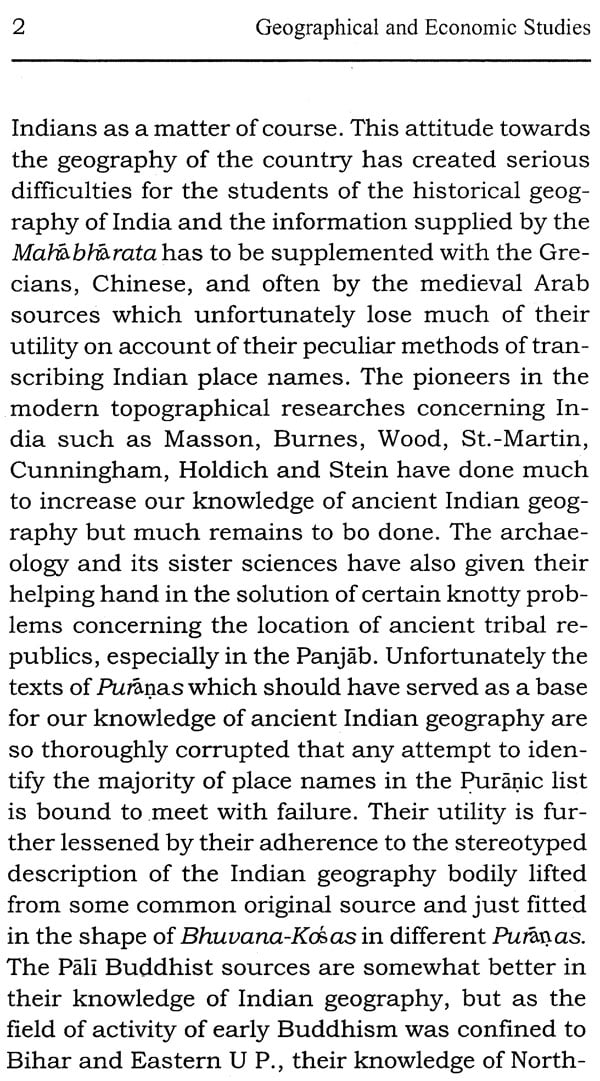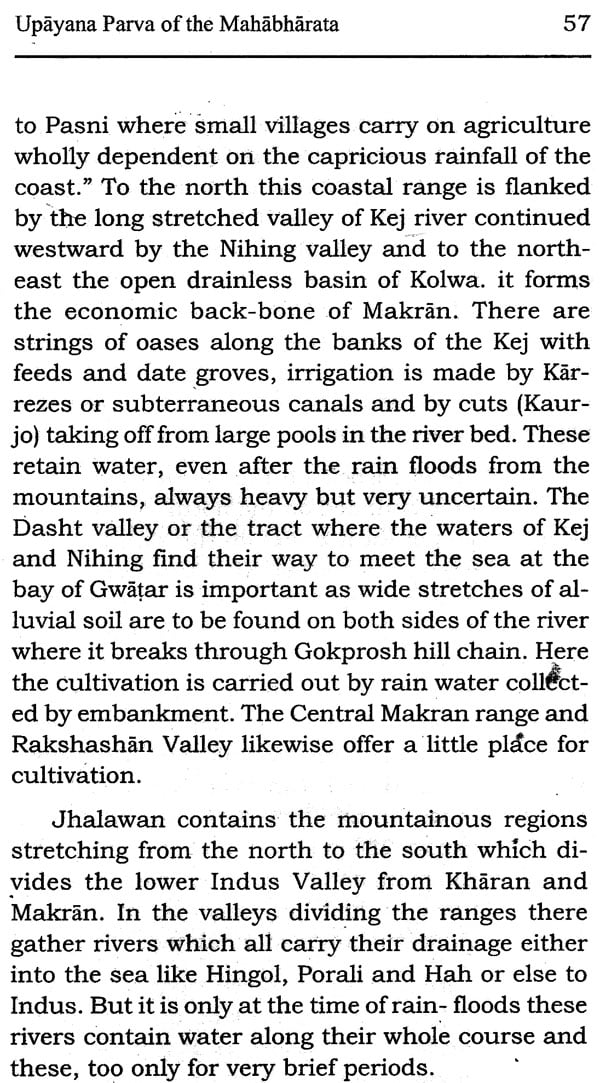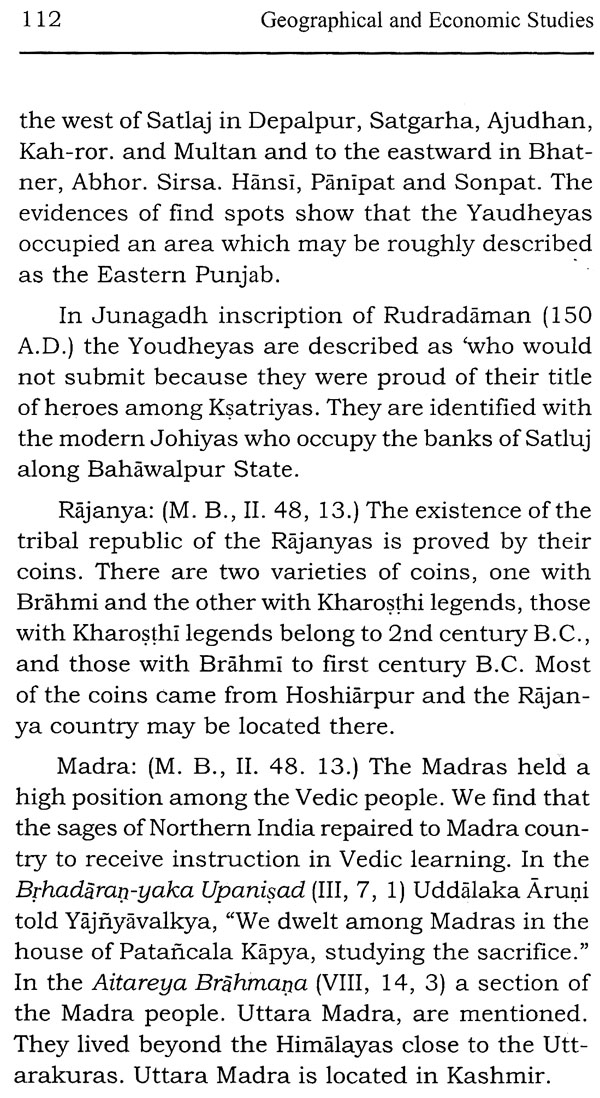
Geographical and Economic Studies in the Mahabharata: Upayana Parva
Book Specification
| Item Code: | NAV306 |
| Author: | Moti Chandra |
| Publisher: | Cosmo Publications, New Delhi |
| Language: | English |
| Edition: | 2019 |
| ISBN: | 9788130718811 |
| Pages: | 155 |
| Cover: | HARDCOVER |
| Other Details | 9.00 X 6.00 inch |
| Weight | 360 gm |
Book Description
In the early days of my return from abroad I was singularly fortunate to come in direct contact of the ennobling and inspiring personality- of the late Dr. K. P, Jayaswal. In his inspiring talks to us he always made it a point to enthuse us about ancient Indian geography without a knowledge of which Indian history in his opinion looked like an open-air drama in which members of the audience are required to do their own guessing about the scenic arrangements. I listened to him with rapt attention, but with my limited knowledge of Indian history and literature I could do little to solve the tangles of Indian historical geography. But there were others who took the cue, and among them foremost stands the name of Prof. Jaya Chandra Vidyalankar. His researches are embodied in an interesting book in Hindi entitled Bharat bhumi our uske Nivasi (India and her peoples), in which he has focussed brilliantly the problems of Indian historical geography. It will not be an exaggeration to say that we have yet to see a book of this type in other Indian languages or as a matter of fact even in European languages. But I stayed where I was, my attention being riveted to problems of art and archaeology: and my profestional duties as the curator of a museum left me sistre time to devote to other subjects. It was therefore a pleasant surprise when my friend Dr. Vasudeva Sharana Agrawala asked me to write an article on the clrapters 47 and 48 of the Sabha-parva which describe in detail the representatives of the tribes and republics who attended the Rajasuya ceremony of Yudhis thira and brought with them various products of their countries as gifts to the great king. I had misgivings about my ability to cope with such a difficult, although fascinating, subject. But I remembered Dr. jayaswal's inspiring words and not minding my limitations entbusiastically took up the work. The deeper I went the greater my fascination grew, and a mere article I proposed to write for Dr. Radha Kumud Presentation Volume swelled into a small book which is before my readers. I purposely chose for my thesis the title of Upayanaparva, although this name does not occur in any of the lists of the sub-parvans of the Mahabharata. The subject-matter of the chapters 47-48 of the Sabhaparva deals with the presents brought by various peoples, and I think the title Upayana-parva appropriately expresses the idea of such gifts. For this liberty I crave the indulgence of scholars.
A word about the geographical information in the Mahabharata should not be out of place here. Before tackling the problems of epic geography utmost caution is necessary to be observed to avoid pitfalls and to gain a straight path in the bewildering forest of names about which we know so little. Mutilated readings found at every step lead us astray, and force us to seek names in the directions in which as the correct readings show they do not exist. Then there are contradictions and repetitions which by the nature of various strata in epic text are inevitable. In these circumstances every piece of evidence has to be weighed carefully before reaching any conclusion. External evidences from Buddhist and Jain sources are also sometimes of utmost value. I must here express my admiration for the critical edition of the Mahabharata in which invariably, except in a very few cases, the choice of the readings by the editor has been correct. I, however, cannot claim that my identifications have always been correct. My modest claim, however, is that I have tried to probe into a difficult subject with my limited knowledge and I am certainly open to corrections which would be welcome. This is just a beginning; the subject of epic geography is far from exhausted. There yet awaits the geography of the Digvijaya-parva and the tangled mass of geographical information in the opening chapters of theBhisma-parvan with hopelessly corrupt text. If everything goes on well I propose to go further into the subject.
The critical study of the Upayana-parva text, however, would have remained an empty dream if the editors of the critical edition of the Mahabharata had not allowed me to consult the text of chapters 47 and 48, while the second part of the Sabhaparvan was still in the Press and which, so far I am aware, has not yet been issued to the subscribers. I am very grateful for all the assistance given to me in this connection by Dr. R. N. Dandekar. The authorities of the Bhandarkar Oriental Research Institute, Poona, also gave me an opportunity to express my views about the geography of the Upayanaparva in a lecture at one of their annual functions. All this encouragement shows how greatly the cooperative spirit has grown among Indian scholars.
In conclusion, I may point out that in spite of my vigilance minor inaccuracies in proof correction have remained in printing; for this I crave the indulgence of the scholars. I also offer my sincerest thanks to Dr. Vasudeva Sharana Agrawala and my young artist friend Ham Subhedar without whose cooperation I could not have successfully accomplished ray task.
**Contents and Sample Pages**











